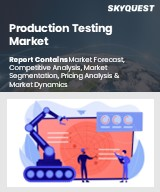
|
시장보고서
상품코드
1777291
생산 시험 시장 규모, 점유율, 성장 분석 : 시험 유형별, 시험 방법별, 용도별, 서비스 유형별, 지역별 - 산업 예측(2025-2032년)Production Testing Market Size, Share, and Growth Analysis, By Testing Type, By Methodology, By Industry Application, By Service Type, By Region - Industry Forecast 2025-2032 |
||||||
세계의 생산 시험 시장 규모는 2023년에 108억 달러에 달하며, 예측 기간(2025-2032년)의 CAGR은 4.1%로, 2024년에는 112억 4,000만 달러, 2032년에는 155억 1,000만 달러로 성장할 것으로 예측됩니다.
세계 생산 테스트 시장은 자동차, 전자, 항공우주, 헬스케어 등의 분야에서 제조 공정의 복잡성 증가와 고품질, 무결점 제품에 대한 수요 증가를 배경으로 강력한 성장이 예상되고 있습니다. 이들 산업에서는 규제 기준을 충족하기 위해 첨단 기술 도입이 진행되고 있으며, 리콜에 따른 비용을 최소화하면서 신뢰성과 안전성을 확보하기 위해 각 생산 단계별로 엄격한 테스트가 요구되고 있습니다. 하지만 고가의 시험 장비에 대한 고가의 설비 투자, 숙련된 인력의 필요성 등의 과제가 성장을 저해할 수 있습니다. 인공지능(AI)과 사물인터넷(IoT)의 통합은 자동화, 예지보전, 실시간 모니터링 강화를 통해 생산 테스트에 혁명을 일으켜 제조 환경의 품질관리와 업무 효율성을 크게 향상시킬 수 있습니다.
목차
서론
- 조사의 목적
- 조사 범위
- 정의
조사 방법
- 정보 조달
- 2차와 1차 데이터 방법
- 시장 규모 예측
- 시장의 전제조건과 제한
개요
- 세계 시장 전망
- 공급과 수요 동향 분석
- 부문별 기회 분석
시장 역학과 전망
- 시장 개요
- 시장 규모
- 시장 역학
- 촉진요인과 기회
- 억제요인과 과제
- Porter의 산업 분석
주요 시장 인사이트
- 주요 성공 요인
- 경쟁의 정도
- 주요 투자 기회
- 시장 에코시스템
- 시장의 매력 지수(2024년)
- PESTEL 분석
- 거시경제 지표
- 밸류체인 분석
- 가격 분석
- 기술 분석
- 사례 연구
생산 시험 시장 규모 : 시험 유형별 & CAGR(2025-2032년)
- 시장 개요
- 생산 시험
- 품질관리 시험
- 환경 시험
- 성능 시험
생산 시험 시장 규모 : 시험 방법별 & CAGR(2025-2032년)
- 시장 개요
- 비파괴 시험
- 파괴 시험
- 육안 검사
- 기능 시험
생산 시험 시장 규모 : 용도별 & CAGR(2025-2032년)
- 시장 개요
- 자동차
- 항공우주
- 제조업
- 일렉트로닉스
- 석유 및 가스
생산 시험 시장 규모 : 서비스 유형별 & CAGR(2025-2032년)
- 시장 개요
- 사내 시험 서비스
- 외부 위탁 시험 서비스
- 컨설팅 서비스
생산 시험 시장 규모 : 지역별 & CAGR(2025-2032년)
- 북미
- 미국
- 캐나다
- 유럽
- 독일
- 스페인
- 프랑스
- 영국
- 이탈리아
- 기타 유럽 지역
- 아시아태평양
- 중국
- 인도
- 일본
- 한국
- 기타 아시아태평양
- 라틴아메리카
- 브라질
- 기타 라틴아메리카 지역
- 중동 및 아프리카
- GCC 국가
- 남아프리카공화국
- 기타 중동 및 아프리카
경쟁 정보
- 상위 5사의 비교
- 주요 기업의 시장 포지셔닝(2024년)
- 주요 시장 기업이 채택한 전략
- 최근 시장 동향
- 기업의 시장 점유율 분석(2024년)
- 주요 기업의 기업 개요
- 기업의 상세
- 제품 포트폴리오 분석
- 기업의 부문별 점유율 분석
- 매출의 전년대비 비교(2022-2024년)
주요 기업 개요
- Baker Hughes Co.
- Expro Group Holdings NV
- Fesco LTD.
- Grant Production Testing Services Ltd
- Halliburton Co.
- Hamdon Energy Solutions Ltd.
- PROFLO Production Testing Ltd.
- Roska DBO Inc.
- Schlumberger Ltd.
- TC Mobile vessels LTD
- testwells Ltd.
- TETRA Technologies Inc.
- Weatherford International Plc
- WELLMAX
- Wespro Production Testing Ltd.
결론과 제안
KSA 25.08.01Global Production Testing Market size was valued at USD 10.80 Billion in 2023 poised to grow between USD 11.24 Billion in 2024 to USD 15.51 Billion by 2032, growing at a CAGR of 4.1% in the forecast period (2025-2032).
The global production testing market is poised for robust growth, driven by the increasing complexity of manufacturing processes and the heightened demand for high-quality, defect-free products across sectors like automotive, electronics, aerospace, and healthcare. These industries are increasingly adopting advanced technologies to meet regulatory standards, necessitating rigorous testing at each production stage to ensure reliability and safety while minimizing costs associated with recalls. However, challenges such as the high capital investment for advanced testing equipment and the need for skilled personnel may impede growth. The integration of Artificial Intelligence (AI) and the Internet of Things (IoT) is revolutionizing production testing through enhanced automation, predictive maintenance, and real-time monitoring, significantly improving quality control and operational efficiency in manufacturing environments.
Top-down and bottom-up approaches were used to estimate and validate the size of the Global Production Testing market and to estimate the size of various other dependent submarkets. The research methodology used to estimate the market size includes the following details: The key players in the market were identified through secondary research, and their market shares in the respective regions were determined through primary and secondary research. This entire procedure includes the study of the annual and financial reports of the top market players and extensive interviews for key insights from industry leaders such as CEOs, VPs, directors, and marketing executives. All percentage shares split, and breakdowns were determined using secondary sources and verified through Primary sources. All possible parameters that affect the markets covered in this research study have been accounted for, viewed in extensive detail, verified through primary research, and analyzed to get the final quantitative and qualitative data.
Global Production Testing Market Segments Analysis
The global cybersecurity insurance market is segmented based on type, services, application, and region. In terms of type, the market is divided into automated test equipment, non-destructive testing equipment, environmental testing equipment, material testing equipment, and other testing equipment. Based on services, the market is bifurcated into testing services, calibration services, maintenance & support services, and consulting services. Based on application, the market is grouped into quality control & inspection, research & development, compliance & certification, and failure analysis. Based on region, the market is segmented into North America, Europe, Asia-Pacific, Latin America and the Middle East and Africa.
Driver of the Global Production Testing Market
The production testing market is significantly influenced by the growing complexity and miniaturization of products across various industries, particularly in electronics, medical devices, and automotive sectors. As components become smaller and more integrated, there's a pressing demand for precise, advanced, and often automated testing solutions. Traditional manual inspection techniques are inadequate for detecting minute defects or ensuring the functionality of these sophisticated products. Consequently, this evolution emphasizes the necessity for advanced testing equipment designed for high-resolution inspection, intricate functional testing, and efficient throughput, thereby driving the demand for innovative production testing technologies in the market.
Restraints in the Global Production Testing Market
One significant challenge facing the global production testing market is the substantial investment required for acquiring advanced testing equipment, coupled with the high operating expenses associated with such technology. The costs extend beyond mere purchase, as advanced automated test equipment, non-destructive testing systems, and environmental testing chambers often entail significant installation and maintenance expenses. Furthermore, these sophisticated systems frequently require specialized software, regular calibration, and skilled personnel for operation and troubleshooting. This confluence of factors contributes to increased operational costs, posing a significant barrier for small and medium-sized enterprises. Consequently, these financial constraints can hinder their ability to fully implement production testing strategies, ultimately affecting market growth.
Market Trends of the Global Production Testing Market
The Global Production Testing Market is witnessing a significant trend driven by the integration of Artificial Intelligence (AI) and Machine Learning (ML) technologies, aimed at enhancing predictive quality and automating inspection processes. Manufacturers are increasingly leveraging AI/ML algorithms to analyze vast amounts of data generated on production lines, enabling them to identify minute anomalies and predict potential defects proactively. This shift from reactive quality control to proactive quality assurance not only improves product yields and minimizes waste but also optimizes testing processes, effectively reducing human error. As a result, the market is poised for robust growth as organizations strive for greater efficiency and quality in their manufacturing operations.
Table of Contents
Introduction
- Objectives of the Study
- Scope of the Report
- Definitions
Research Methodology
- Information Procurement
- Secondary & Primary Data Methods
- Market Size Estimation
- Market Assumptions & Limitations
Executive Summary
- Global Market Outlook
- Supply & Demand Trend Analysis
- Segmental Opportunity Analysis
Market Dynamics & Outlook
- Market Overview
- Market Size
- Market Dynamics
- Drivers & Opportunities
- Restraints & Challenges
- Porters Analysis
- Competitive rivalry
- Threat of substitute
- Bargaining power of buyers
- Threat of new entrants
- Bargaining power of suppliers
Key Market Insights
- Key Success Factors
- Degree of Competition
- Top Investment Pockets
- Market Ecosystem
- Market Attractiveness Index, 2024
- PESTEL Analysis
- Macro-Economic Indicators
- Value Chain Analysis
- Pricing Analysis
- Technology Analysis
- Case Studies
Global Production Testing Market Size by Testing Type & CAGR (2025-2032)
- Market Overview
- Production Testing
- Quality Control Testing
- Environmental Testing
- Performance Testing
Global Production Testing Market Size by Methodology & CAGR (2025-2032)
- Market Overview
- Non-Destructive Testing
- Destructive Testing
- Visual Inspection
- Functional Testing
Global Production Testing Market Size by Industry Application & CAGR (2025-2032)
- Market Overview
- Automotive
- Aerospace
- Manufacturing
- Electronics
- Oil and Gas
Global Production Testing Market Size by Service Type & CAGR (2025-2032)
- Market Overview
- In-house Testing Services
- Outsourced Testing Services
- Consulting Services
Global Production Testing Market Size & CAGR (2025-2032)
- North America (Testing Type, Methodology, Industry Application, Service Type)
- US
- Canada
- Europe (Testing Type, Methodology, Industry Application, Service Type)
- Germany
- Spain
- France
- UK
- Italy
- Rest of Europe
- Asia Pacific (Testing Type, Methodology, Industry Application, Service Type)
- China
- India
- Japan
- South Korea
- Rest of Asia-Pacific
- Latin America (Testing Type, Methodology, Industry Application, Service Type)
- Brazil
- Rest of Latin America
- Middle East & Africa (Testing Type, Methodology, Industry Application, Service Type)
- GCC Countries
- South Africa
- Rest of Middle East & Africa
Competitive Intelligence
- Top 5 Player Comparison
- Market Positioning of Key Players, 2024
- Strategies Adopted by Key Market Players
- Recent Developments in the Market
- Company Market Share Analysis, 2024
- Company Profiles of All Key Players
- Company Details
- Product Portfolio Analysis
- Company's Segmental Share Analysis
- Revenue Y-O-Y Comparison (2022-2024)
Key Company Profiles
- Baker Hughes Co.
- Company Overview
- Business Segment Overview
- Financial Updates
- Key Developments
- Expro Group Holdings NV
- Company Overview
- Business Segment Overview
- Financial Updates
- Key Developments
- Fesco LTD.
- Company Overview
- Business Segment Overview
- Financial Updates
- Key Developments
- Grant Production Testing Services Ltd
- Company Overview
- Business Segment Overview
- Financial Updates
- Key Developments
- Halliburton Co.
- Company Overview
- Business Segment Overview
- Financial Updates
- Key Developments
- Hamdon Energy Solutions Ltd.
- Company Overview
- Business Segment Overview
- Financial Updates
- Key Developments
- PROFLO Production Testing Ltd.
- Company Overview
- Business Segment Overview
- Financial Updates
- Key Developments
- Roska DBO Inc.
- Company Overview
- Business Segment Overview
- Financial Updates
- Key Developments
- Schlumberger Ltd.
- Company Overview
- Business Segment Overview
- Financial Updates
- Key Developments
- TC Mobile vessels LTD
- Company Overview
- Business Segment Overview
- Financial Updates
- Key Developments
- testwells Ltd.
- Company Overview
- Business Segment Overview
- Financial Updates
- Key Developments
- TETRA Technologies Inc.
- Company Overview
- Business Segment Overview
- Financial Updates
- Key Developments
- Weatherford International Plc
- Company Overview
- Business Segment Overview
- Financial Updates
- Key Developments
- WELLMAX
- Company Overview
- Business Segment Overview
- Financial Updates
- Key Developments
- Wespro Production Testing Ltd.
- Company Overview
- Business Segment Overview
- Financial Updates
- Key Developments




















